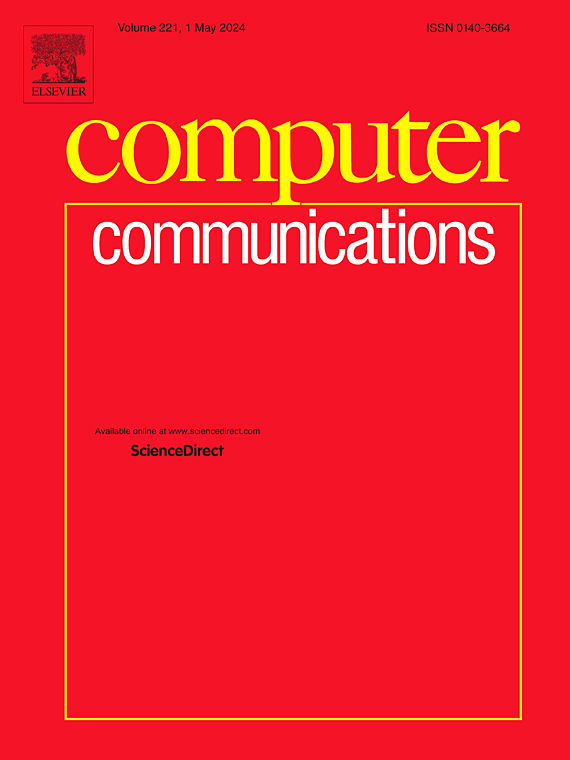Time varying channel estimation for RIS assisted network with outdated CSI: Looking beyond coherence time
IF 4.3
3区 计算机科学
Q1 COMPUTER SCIENCE, INFORMATION SYSTEMS
引用次数: 0
Abstract
The channel estimation (CE) overhead for unstructured multipath-rich channels increases linearly with the number of reflective elements of reconfigurable intelligent surface (RIS). This results in a significant portion of the channel coherence time being spent on CE, reducing data communication time. Furthermore, due to the mobility of the user equipment (UE) and the time consumed during CE, the estimated channel state information (CSI) may become outdated during actual data communication. In recent studies, the timing for CE has been primarily determined based on the coherence time interval, which is dependent on the velocity of the UE. However, the effect of the current channel condition and pathloss of the UEs can also be utilized to control the duration between successive CE to reduce the overhead while still maintaining the quality of service. Furthermore, for multi-user systems, the appropriate coherence time intervals of different users may be different depending on their velocities. Therefore CE carried out ignoring the difference in coherence time of different UEs may result in the estimated CSI being detrimentally outdated for some users. In contrast, others may not have sufficient time for data communication. To this end, based on the throughput analysis on outdated CSI, an algorithm has been designed to dynamically predict the next time instant for CE after the current CSI acquisition. In the first step, optimal RIS phase shifts to maximize channel gain is computed. Based on this and the amount of degradation of signal to interference plus noise ratio due to outdated CSI, transmit powers and bandwidth are allocated for the UEs and finally the next time instant for CE is predicted such that the aggregated throughput is maximized. Simulation results confirm that our proposed algorithm outperforms the coherence time-based strategies and an existing algorithm that adaptively changes inter CE duration.
基于过时CSI的RIS辅助网络时变信道估计:超越相干时间
非结构化多径富信道的信道估计开销随着可重构智能面(RIS)反射元素数量的增加呈线性增加。这导致很大一部分信道相干时间花在CE上,从而减少了数据通信时间。此外,由于用户设备(UE)的移动性和CE期间消耗的时间,估计的信道状态信息(CSI)可能在实际数据通信中过时。在最近的研究中,主要是根据相干时间间隔来确定CE的时间,而相干时间间隔取决于UE的速度。但是,也可以利用ue的当前信道状况和路径损耗的影响来控制连续CE之间的持续时间,从而在保持服务质量的同时减少开销。此外,对于多用户系统,不同用户的适当相干时间间隔可能因其速度而异。因此,忽略不同ue的相干时间差异进行CE可能会导致估计的CSI对某些用户来说是有害的过时。相比之下,其他人可能没有足够的时间进行数据通信。为此,在对过时CSI的吞吐量分析的基础上,设计了一种算法来动态预测当前CSI采集后CE的下一个时间点。第一步,计算最优的RIS相移以最大化信道增益。基于此以及由于过时的CSI而导致的信噪比退化量,为ue分配发射功率和带宽,最后预测CE的下一个时间瞬间,从而使聚合吞吐量最大化。仿真结果证实了我们提出的算法优于基于相干时间的策略和现有的自适应改变CE持续时间的算法。
本文章由计算机程序翻译,如有差异,请以英文原文为准。
求助全文
约1分钟内获得全文
求助全文
来源期刊

Computer Communications
工程技术-电信学
CiteScore
14.10
自引率
5.00%
发文量
397
审稿时长
66 days
期刊介绍:
Computer and Communications networks are key infrastructures of the information society with high socio-economic value as they contribute to the correct operations of many critical services (from healthcare to finance and transportation). Internet is the core of today''s computer-communication infrastructures. This has transformed the Internet, from a robust network for data transfer between computers, to a global, content-rich, communication and information system where contents are increasingly generated by the users, and distributed according to human social relations. Next-generation network technologies, architectures and protocols are therefore required to overcome the limitations of the legacy Internet and add new capabilities and services. The future Internet should be ubiquitous, secure, resilient, and closer to human communication paradigms.
Computer Communications is a peer-reviewed international journal that publishes high-quality scientific articles (both theory and practice) and survey papers covering all aspects of future computer communication networks (on all layers, except the physical layer), with a special attention to the evolution of the Internet architecture, protocols, services, and applications.
 求助内容:
求助内容: 应助结果提醒方式:
应助结果提醒方式:


